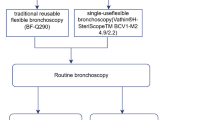Abstract
The aim of this study was to evaluate patient’s experience when performing transnasal flexible endoscopy using EndoSheath Technology without sedation in an ENT outpatient department. Patients were seen at the laryngological clinic of the Department of Otorhinolaryngology, Head and Neck Surgery, University Hospital Heidelberg, presenting with complaints of reflux like throat cleaning, persistent cough, globus sensation, heartburn, or voice problems. First, we performed stroboscopy. In cases where physical examination findings revealed the presence of LPR, we performed a transnasal flexible esophagoscopy (TNE) using sterile EndoSheath Technology under local anesthesia. 55 patients were investigated and completed a questionnaire on subjective discomfort that they felt during the procedure. The different steps of the examination were assessed separately. Complications were noted down by the surgeon. All patients underwent a complete examination of the upper aerodigestive tract. The time needed for preparation, examination and cleaning measures was recorded as well. The average preparation time for each examination was 24 min. No complications were observed during the procedure. The procedure was well tolerated by all patients and was classified on average as “low-grade unpleasant”. In summary, TNE is a safe, quick and well-tolerated procedure that can be performed in a regular examination room under local anesthesia without sedation.








Similar content being viewed by others
References
Aviv JE, Tokoudes TG, Ma G, Close LG (2001) Office based esophagoscopy: a preliminary report. Otolaryngol Head Neck Surg 125:170–175
Belafsky PC, Postma GN, Daniel E, Koufman JA (2001) Transnasal esophagoscopy. Otolaryngol Head Neck Surg 125:588–589
Seth AK, Puri P, Chandra A (2009) Role of ultrathin transnasal esophagogastroduodenoscopy: experience with 50 patients. Indian J Gastroenterol 28:183–185
Sharma A, Price T, Mierzwa K, Montgomery P, Qayyum A, Bradnam T (2006) Transnasal flexible laryngo-oesophagoscopy: an evaluation of the patient′s experience. J Laryngol Otol 120:24–31
Dumortier J, Napoleon B, Hedelius F, Pellissier PE, Leprince E, Pujol B, Ponchon T (2003) Unsedated transnasal EGD in daily practice: results with 1100 consecutive patients. Gastrointest Endosc 57:198–204
Craig A, Hanlon J, Dent J, Schoeman M (1999) A comparison of transnasal and transoral endoscopy in unsedated patients. Gastrointest Endosc 49:292–296
Dumortier J, Josso C, Roman S, Fumex F, Lepilliez V, Prost B, Lot M, Guillaud O, Petit-Laurent F, Lapalus MG, Ponchon T (2007) Prospective evaluation of a new ultrathin one-plane bending videoendoscope for transnasal EGD: a comparative study on performance and tolerance. Gastrointest Endosc 66:13–19
Leder SB, Ross DA, Briskin KB, Saski CT (1997) A prospective, double-blind randomized study on the use of topical anaesthetic, vasoconstrictor, and placebo during flexible fiberoptic endoscopy. J Speech Lang Hearing Res 40:1352–1357
Campo R, Montserrat A, Brullet E (1998) Transnasal gastroscopy compared to conventional gastroscopy: a randomized study of feasibility, safety, and tolerance. Endoscopy 30:448–452
Chung JW, Park S, Chung MJ, Park JY, Park SW, Chung JB, Song SY (2012) A novel disposable, transnasal esophagoscope: a pilot trial of feasibility, safety, and tolerance. Endoscopy 44:206–209
Price T, Sharma A, Snelling J, Bennett AMD, Qayyum A, Bradnam T, Montgomery P (2005) How we do it: the role of transnasal flexible laryngo-oesophagoscopy (TNFLO) in ENT: one year′s experience in a head and neck orientated practice in the UK. Clin Otolaryngol 30:551–556
Elackattu A, Zoccoli M, Spiegel JH, Grundfast KM (2010) A comparison of two methods for preventing cross-contamination when using flexible fiberoptic endoscopes in an otolaryngology clinic: disposable sterile sheaths versus immersion in germicidal liquid. Laryngoscope 24:10–16
Jecker P (2012) The possibilities of reflux disease diagnosis by the ear, nose and throat specialist. HNO 60:186–192
Author information
Authors and Affiliations
Corresponding author
Rights and permissions
About this article
Cite this article
Streckfuss, A., Bosch, N., Plinkert, P.K. et al. Transnasal flexible esophagoscopy (TNE): an evaluation of the patient’s experience and time management. Eur Arch Otorhinolaryngol 271, 323–328 (2014). https://doi.org/10.1007/s00405-013-2633-7
Received:
Accepted:
Published:
Issue Date:
DOI: https://doi.org/10.1007/s00405-013-2633-7



